Abstract
Phloroglucinol is a valuable chemical which has been successfully produced by metabolically engineered Escherichia coli. However, the low productivity remains a bottleneck for large-scale application and cost-effective production. In the present work, we cloned the key biosynthetic gene, phlD (a type III polyketide synthase), into a bacterial expression vector to produce phloroglucinol in E. coli and developed different strategies to re-engineer the recombinant strain for robust synthesis of phloroglucinol. Overexpression of E. coli marA (multiple antibiotic resistance) gene enhanced phloroglucinol resistance and elevated phloroglucinol production to 0.27 g/g dry cell weight. Augmentation of the intracellular malonyl coenzyme A (malonyl-CoA) level through coordinated expression of four acetyl-CoA carboxylase (ACCase) subunits increased phloroglucinol production to around 0.27 g/g dry cell weight. Furthermore, the coexpression of ACCase and marA caused another marked improvement in phloroglucinol production 0.45 g/g dry cell weight, that is, 3.3-fold to the original strain. Under fed-batch conditions, this finally engineered strain accumulated phloroglucinol up to 3.8 g/L in the culture 12 h after induction, corresponding to a volumetric productivity of 0.32 g/L/h. This result was the highest phloroglucinol production to date and showed promising to make the bioprocess economically feasible.





Similar content being viewed by others
References
Achkar J, Xian M, Zhao H, Frost JW (2005) Biosynthesis of phloroglucinol. J Am Chem Soc 127:5332–5333
Alekshun MN, Levy SB (1999) Alteration of the repressor activity of MarR, the negative regulator of the Escherichia coli marRAB locus, by multiple chemicals in vitro. J Bacteriol 181:4669–4672
Antoni D, Zverlov V, Schwarz W (2007) Biofuels from microbes. Appl Microbiol Biotechnol 77:23–35
Bangera MG, Thomashow LS (1999) Identification and characterization of a gene cluster for synthesis of the polyketide antibiotic 2,4-diacetylphloroglucinol from Pseudomonas fluorescens Q2-87. J Bacteriol 181:3155–3163
Cronan JE, Waldrop GL (2002) Multi-subunit acetyl-CoA carboxylases. Prog Lipid Res 41:407–435
Davis MS, Solbiati J, Cronan JE (2000) Overproduction of acetyl-CoA carboxylase activity increases the rate of fatty acid biosynthesis in Escherichia coli. J Biol Chem 275:28593–28598
De La Fuente L, Mavrodi DV, Landa BB, Thomashow LS, Weller DM (2006) PhlD-based genetic diversity and detection of genotypes of 2,4-diacetylphloroglucinol-producing Pseudomonas fluorescens. FEMS Microbiol Ecol 56:64–78
de Werra P, Pechy-Tarr M, Keel C, Maurhofer M (2009) Role of gluconic acid production in the regulation of biocontrol traits of Pseudomonas fluorescens CHA0. Appl Environ Microbiol 75:4162–4174
Fowler ZL, Gikandi WW, Koffas MAG (2009) Increasing malonyl-CoA biosynthesis by tuning the Escherichia coli metabolic network and its application to flavanone production. Appl Environ Microbiol. doi:AEM.00270-00209
Frost JW (2007) Biosynthesis of phloroglucinol and preparation of 1,3-dihydroxybenzene therefrom. Patent application no. US20070178571
Gambino L, Gracheck SJ, Miller PF (1993) Overexpression of the MarA positive regulator is sufficient to confer multiple antibiotic resistance in Escherichia coli. J Bacteriol 175:2888–2894
Hayashi O, Satoh K (2006) Determination of acetyl-CoA and malonyl-CoA in germinating rice seeds using the LC-MS/MS technique. Biosci Biotechnol Biochem 70:2676–2681
Hunt DE, Sandham HJ (1969) Improved agar gradient-plate technique. Appl Environ Microbiol 17:329–330
Leonard E, Lim K-H, Saw P-N, Koffas MAG (2007) Engineering central metabolic pathways for high-level flavonoid production in Escherichia coli. Appl Environ Microbiol 73:3877–3886
Mavrodi OV, Gardener BBM, Mavrodi DV, Bonsall RF, Weller DM, Thomashow LS (2001) Genetic diversity of phlD from 2,4-diacetylphloroglucinol-producing fluorescent Pseudomonas spp. Phytopathology 91:35–43
Miyahisa I, Kaneko M, Funa N, Kawasaki H, Kojima H, Ohnishi Y, Horinouchi S (2005) Efficient production of (2S)-flavanones by Escherichia coli containing an artificial biosynthetic gene cluster. Appl Microbiol Biotechnol 68:498–504
Moynihan JA, Morrissey JP, Coppoolse ER, Stiekema WJ, O’Gara F, Boyd EF (2009) Evolutionary history of the phl gene cluster in the plant-associated bacterium Pseudomonas fluorescens. Appl Environ Microbiol 75:2122–2131
Pfeifer BA, Admiraal SJ, Gramajo H, Cane DE, Khosla C (2001) Biosynthesis of complex polyketides in a metabolically engineered strain of E. coli. Science 291:1790–1792
Randall LP, Woodward MJ (2002) The multiple antibiotic resistance (mar) locus and its significance. Res Vet Sci 72:87–93
Schneiders T, Barbosa TM, McMurry LM, Levy SB (2004) The Escherichia coli transcriptional regulator MarA directly represses transcription of purA and hdeA. J Biol Chem 279:9037–9042
Shanahan P, O’Sullivan DJ, Simpson P, Glennon JD, O’Gara F (1992) Isolation of 2,4-diacetylphloroglucinol from a fluorescent Pseudomonad and investigation of physiological parameters influencing its production. Appl Environ Microbiol 58:353–358
Singh IP, Bharate SB (2006) Phloroglucinol compounds of natural origin. Nat Prod Rep 23:558–591
Singh IP, Sidana J, Bansal P, Foley WJ (2009) Phloroglucinol compounds of therapeutic interest: global patent and technology status. Expert Opin Ther Pat 19:847–866
Slininger P, Shea-Andersh M (2005) Proline-based modulation of 2,4-diacetylphloroglucinol and viable cell yields in cultures of Pseudomonas fluorescens wild-type and over-producing strains. Appl Microbiol Biotechnol 68:630–638
Takamura Y, Nomura G (1988) Changes in the intracellular concentration of acetyl-CoA and malonyl-CoA in relation to the carbon and energy metabolism of Escherichia coli K12. J Gen Microbiol 134:2249–2253
Validov S, Mavrodi O, De La Fuente L, Boronin A, Weller D, Thomashow L, Mavrodi D (2005) Antagonistic activity among 2,4-diacetylphloroglucinol-producing fluorescent Pseudomonas spp. FEMS Microbiol Lett 242:249–256
Wadler C, Cronan JE (2007) Dephospho-CoA kinase provides a rapid and sensitive radiochemical assay for coenzyme A and its thioesters. Anal Biochem 368:17–23
Weller DM, Landa BB, Mavrodi OV, Schroeder KL, De La Fuente L, Bankhead SB, Molar RA, Bonsall RF, Mavrodi DV, Thomashow LS (2007) Role of 2,4-diacetylphloroglucinol-producing fluorescent Pseudomonas spp. in the defense of plant roots. Plant Biol 9:4–20
Willke T, Vorlop KD (2004) Industrial bioconversion of renewable resources as an alternative to conventional chemistry. Appl Microbiol Biotechnol 66:131–142
Zha W, Rubin-Pitel SB, Zhao H (2006) Characterization of the substrate specificity of PhlD, a type III polyketide synthase from Pseudomonas fluorescens. J Biol Chem 281:32036–32047
Zha W, Rubin-Pitel SB, Shao Z, Zhao H (2009) Improving cellular malonyl-CoA level in Escherichia coli via metabolic engineering. Metab Eng 11:192–198
Zhao J, Shimizu K (2003) Metabolic flux analysis of Escherichia coli K12 grown on 13C-labeled acetate and glucose using GC-MS and powerful flux calculation method. J Biotechnol 101:101–117
Acknowledgment
This research was sponsored by National Natural Science Foundation (no. 20872075). The authors would like to thank Dr. Haiyan Yang for ion chromatography analysis and Dr. Cong Wang for LC-MS analysis.
Author information
Authors and Affiliations
Corresponding author
Rights and permissions
About this article
Cite this article
Cao, Y., Jiang, X., Zhang, R. et al. Improved phloroglucinol production by metabolically engineered Escherichia coli . Appl Microbiol Biotechnol 91, 1545–1552 (2011). https://doi.org/10.1007/s00253-011-3304-5
Received:
Revised:
Accepted:
Published:
Issue Date:
DOI: https://doi.org/10.1007/s00253-011-3304-5




